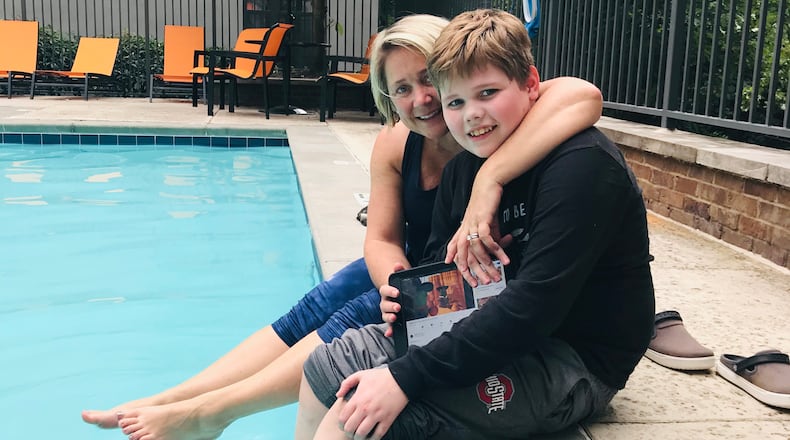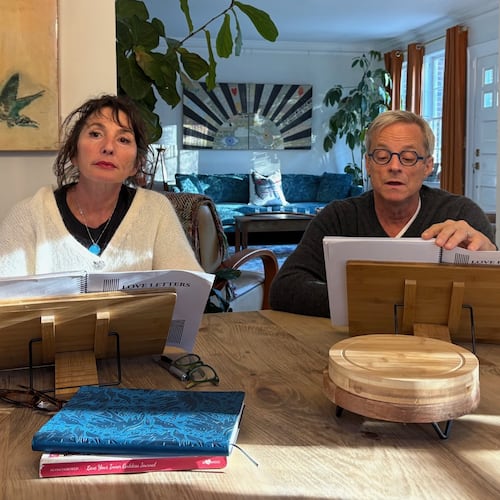Brooke Olson recalls the days of crouching in a fetal position while her son ripped her hair out, kicked and hit her as hard as he could. “You can’t (imagine) being in combat with your child, the person you love more than anything else,” she says. “He would come at me, and I’d be in a ball crying, sobbing. I was either going to hurt him or take it and just protect myself, so I just took it. I was scared to death of him. We couldn’t let anyone be alone with him.”
Olson’s child, Amick, now 15, isn’t a bad, angry, disturbed, mean young man. He is severely autistic and didn’t know how to handle stimulus, change or his frustrations. Recently, she and Amick went to the beach by themselves, rode in a golf cart and swam in the ocean. “It was the first time I was able to do something by myself with my child in so long. I couldn’t (imagine) us doing this two-and-a-half years ago.”
Olson attributes the drastic change to one thing: the Marcus Autism Center. The center, which was started by the Home Depot’s co-founder Bernie Marcus, is one of the largest autism centers in the U.S. and one of only five National Institutes of Health Autism Centers of Excellence in the country. In 2008 it became part of Children’s Healthcare of Atlanta, and today treats more than 5,500 children with autism and related disorders a year. Last year, The Centers for Disease Controls estimated that approximately one in 54 children are diagnosed as being on the autism spectrum. An estimated 5.4 million adults are on the spectrum as well.
To parents like Olson, Marcus is a lifesaver, perhaps literally. “I am so thankful for Marcus. It changed our lives, and I’m thankful we did it before he hit puberty. Amick is now a teddy bear. He is literally loved to pieces by his teachers — the same people who were absolutely scared to death of him.”
Amick’s transformation was not a “miracle,” she emphasizes. “It wasn’t turning a switch, on and we now have happiness and serenity. It was years of making it happen.”
Dr. Joanna Lomas Mevers, program director of the Severe Behavior Program at Marcus, says that when severely autistic individuals exhibit challenging behavior, it is often because they have no skills to communicate what they need. “If you are nonverbal or have limited verbal skills, you can’t say that you’re tired or that you don’t want your iPad taken away.”
Kids “really can significantly do damage to themselves and others, and sometimes using safe and limited invasive strategies is the only way to keep everyone safe, at least until there is an effective treatment option,” she says. But, with intensive training for the caregivers and the individual, change can occur. “Our approach is the same whether the person is two or 18. We want to teach them a better way to communicate what they want. But it is different when a 3-year-old hits you, you can take a few punches, but some things are modified when the patient is 15, 6 feet tall and weighs 260 pounds. And, puberty and hormones do bring new challenges.”
Credit: Handout
Credit: Handout
There are methods to help the person communicate in alternative ways, such as sign language, a card exchange or an augmentative device. “Most of the children I work with understand what you are saying and know what they want to say, but a lot of kids with autism have no effective way of telling us they understand or have an effective way to communicate what they want. I don’t worry about a person’s IQ. We work with kids with a wide variety of IQs, some higher than mine, others who are so low they’re not even testable. But even kids who are significantly impaired can learn how to communicate.”
The Center’s Severe Behavior Program provides a variety of treatment options for behaviors such as aggression, destructive and dangerous behavior, eating non-food items, running away, hurting oneself and noncompliance. Working with doctors and therapists, they discover why the problem behavior occurs, develop a treatment plan to reduce bad behavior and increase appropriate ones. The next step is to integrate treatment strategies into everyday life.
One way to communicate is with a visual stimuli board where the person is taught to communicate using pictures and slowly understands and tolerates that they can’t always get what they want when they want it. “It’s hard for them not to have what they want. That’s the challenge; it’s the challenge for everyone,” Dr. Lomas Mevers says.
Like many parents with autistic children, the Olsons were met with a variety of medical answers about Amick’s condition. “We even had a doctor tell me he had scurvy because he wouldn’t eat. I had doctors say it was because boys were less verbal and another gave me a brochure on how to be a better parent and discipline your child.”
In fact, Olson, who lives in Columbus, Ohio, was referred to Marcus for its feeding program rather than for behavioral issues. But after the consultation, the subject of incorporating a severe behavioral team came up. The commitment involved living for at least eight weeks in Atlanta. “In my mind and heart, I knew he needed the behavior programs. I hadn’t realized how much help we needed, but it was obvious. The professionals were looking at me like this is not normal, but we can make it better.”
The Marcus team was very clear that it will get worse before it get better, and it did. Instead of eight weeks, it was seven months. “We just went through all sorts of things, but I’m happy to say that we left with a really great behavior plan.”
Credit: Handout
Credit: Handout
Breakthroughs were made, both for Amick and his mother. Through Marcus, Olson realized that Amick was similar to a person in a foreign country who doesn’t speak the language, is put in a car and doesn’t know he’s going. The anxiety, nervousness and fear take over and cause the person to act irrationally, often physically.
“The severity of his behavior got worse over time, over the years. It wasn’t like he woke up and said I’m going to hit you as hard as I can until I get my way,” Olson says. “He is a strong-willed persistent person who doesn’t like interruptions to his environment.” But the way the Marcus Center explained it to her, it all made sense.
The situation, as the Center professionals told her, did get worse before it got better. “We worked for seven months on how to better communicate and behave, and sometimes I wasn’t sure that seven months was going to be enough.”
Olson knows that she is fortunate to have the time and money to spend with Amick in Atlanta while her husband and two other children stayed at home. “I think my daughter, who is 17, feels that she got gypped out of her childhood. We spent all our time with Amick, and of course, we couldn’t go anywhere, certainly not spontaneously. Our home was our sanctuary.”
Today Amick is in the eighth grade at his local public school in a specialized learning center. The classroom teacher and district trainer follow the instructions and lessons on how to interact and manage Amick’s behavior. “Every teacher follows this behavior plan, which is why it works. He’s maybe had two behavioral outbursts this year. Marcus also has a crisis intervention program that helped me.”
Dr. Lomas Mevers says Olson’s story is, unfortunately, all too familiar. “Parents feel isolated and trapped in their house. You need to integrate the child into a normal life as much as you can because everyone benefits. Parents have to choose their battles well and know that when they are putting their child into a situation that they will know how to manage it.”
Olson’s best friend is going through a similar situation with her child but is not able to go to Marcus; financially, she can’t make it happen. “She just comes to my house and cries,” she says. “I am thankful for any and every story shared on this topic. Parents need to know they aren’t alone, and there are ways to get help. The only way to get funding and support for more programs, like Marcus Autism Center’s Severe behavior clinic, is to share my story and stories like it.”
There are long waiting lists at Marcus to get into the program, and in severe cases, the wait can be up to two years. “I’d love to have the solution; it’s what keeps me up at night. There aren’t enough trainers and professionals. There are funding challenges,” Dr. Lomas Mevers says. “We not only are helping the child, but we help families access resources including mental health services because many of them are struggling with their own mental health. We just need more resources to come to table.”
Olson understands the value of what the Marcus Center did for Amick and her family. “If I had a million dollars, I’d give it to Marcus,” says Olson.
About the Author
Keep Reading
The Latest
Featured





